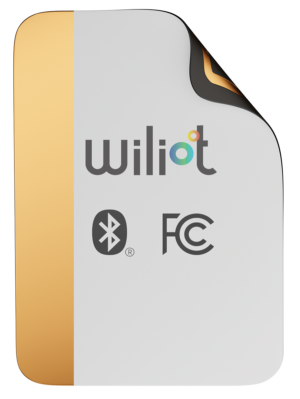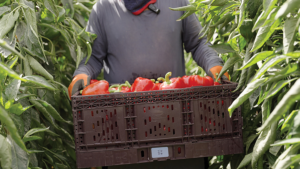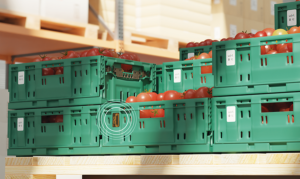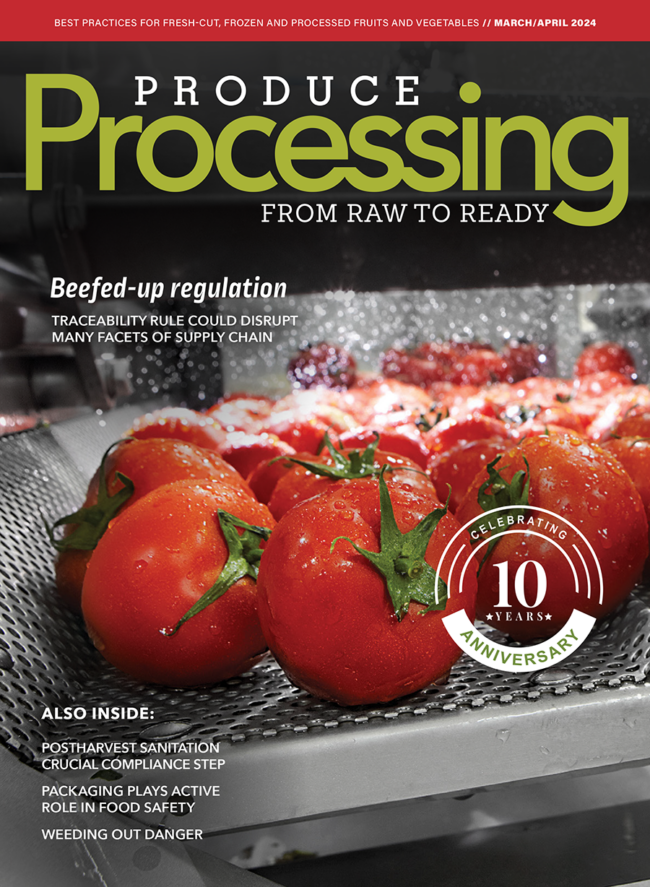Sensing the future: High-tech platform harnesses IoT power for produce
Wiliot’s award-winning labeling technology stemmed from discouragement.
The international IoT data carrier platform company recently won recognition from Time magazine, with its ambient IoT Pixels and Visibility Platform making that publication’s list of Best Inventions of 2023. Wiliot’s stamp-sized, self-powered compute devices affix to a product, such as a crate of tomatoes, and connect it to the internet, transmitting real-time information such as location and temperature.

In September, Wiliot added humidity sensing capabilities — its latest move in scaling up to meet both consumer demand and the plethora of possibilities inherent in the IoT, which enables devices with sensors and processing ability to connect and exchange data.
But, as Steve Statler, chief marketing officer for Wiliot, explained to Produce Processing, that innovation was sparked by dissatisfaction.
HOW DID WILIOT’S IOT PIXELS AND VISIBILITY PLATFORM EVOLVE?
STEVE STATLER (SS): The company was formed around this notion that the Internet of Things, not just connecting browsers but connecting things, has been a bit of a disappointment so far. The scale and the impact of the use cases have been less than what everyone had hoped. The reason basically comes down to cost. You’re either dealing with expensive tags, or the device that went on the things could be pricey — tens of dollars, hundreds of dollars. (We) were looking for, What’s the sequel to this story?
It’s a technical marvel, creating these compute devices that are the size of a postage stamp and power themselves without batteries by harvesting or recycling the energy from radio waves. … We’re surrounded by a whole mass of radio devices just waiting for someone to tap into it, and that’s what we’re doing. The big difference between this latest take on the Internet of Things, the ambient Internet of Things, is that the costs are low. The devices and tags cost very little. The infrastructure largely already exists, and the things you need to fill in the gaps are tens of dollars, not hundreds or thousands of dollars, and it doesn’t require anyone to tap or scan.
TELL US MORE ABOUT THE DEVICE.
SS: It has an FCC (Federal Communications Commission) and a Bluetooth logo on it — Bluetooth because it talks to your phone, and an FCC logo says that it’s an active radio — taking energy from a weak signal and producing a stronger signal. It has three antennas. One broadcasts Bluetooth; it talks to phones, smart speakers, Bluetooth radios and fridges. The other two are used for harvesting energies at different frequencies and are the key to eliminating the battery.
ARE THERE PLANS TO INCREASE THE TECHNOLOGY’S ACCESSIBILITY?
SS: A demo project we’re working on (is) an open-source software. We’re taking the code that we used to write this app, which is an iPhone app, and sharing it openly. Anyone can take that and incorporate this into their own browser. This is living web. It will browse things and places that have IoT pixel tags on them.
It does three things: It can hear, see and remember. The hearing bit is hearing the broadcast from tags or pixels that are nearby. At the moment, these have rather cryptic asset IDs, but in the next version of this, this will say lettuce, tomatoes and product names. The idea is I can hear the products that are nearby without having to tap or scan because Bluetooth is pushing the data to me. But then if I actually want to see information about that product, this is the digital passport. … The remembering is in the details of the passport: Where did this product come from? Where’s it going to? What’s the temperature history?
We’re going to open this up to people that aren’t even using our product. It will work with regular QR codes. We want this to be used more generally to inspect digital passports and help increase visibility for data that doesn’t necessarily fit on a small sticker on a product.

HOW WILL INCREASED VISIBILITY IMPACT BOTH PRODUCERS AND CONSUMERS?
SS: The devices will not just track where the trailer is but what’s in the trailer and the state of it. Being able to measure what’s in the trailer is a huge step forward. There’s a lot of misshipment that results in wasted products and disappointed customers when the right thing goes to the wrong store.
Being able to measure the temperature is amazing because it turns out that we’re seeing things that have never been seen before — strawberries being frozen and defrosted multiple times on the way to the distribution center and the store. Then if you add humidity, you really start to move to this nirvana of having freshness sensing and ripeness sensing, and that allows a better product to be put in front of customers and a reduction in waste. You can start to control what gets taken from the cold store in the back of the grocery store and put in the front, not just based on production dates or sell- by dates but on ripest first. That means better-tasting, better-looking products in front of consumers that they buy, and less waste, which is better for the environment and better for the bottom line.
(Shoppers) can see where the food’s coming from and much more information about it: What is the carbon footprint of
this banana versus that banana? Where does this product come from? It gives (consumers) much more visibility, which I think actually could mean that some of the commodity players in the market, the value players, could end up having more premium products that satisfy higher standards.
WHAT CHALLENGES HAS WILIOT FACED IN DEVELOPING THIS PLATFORM?
SS: It’s taken six years to get this far. (This) chip is the second-generation product chip. There’s probably been maybe nine or 10 of these chips that are produced, and each one is a bit of a gamble. The process of producing one of these chips takes months and months and months, and you don’t know whether it’s going to work when it comes back. It’s a very expensive process, especially when you’re producing them at a scale.
There’s been a bunch of technical challenges, (but) one of the biggest challenges is getting people to think differently. I think in five years’ time, this will just seem like part of the wallpaper. In fact, it will be in the wallpaper. These ambient IoT tags will be everywhere. They’ll be in the wallpaper, the picture frames, the window panes. They’ll be on food, medicine, clothing.
WHAT HAS THE RESPONSE TO THE TECHNOLOGY BEEN LIKE SO FAR?
SS: It’s early days. We just came back from (a trade show) two weeks ago in Australia. I was very pleased with the reception. Some of the players in this grocery supply chain, the downstream players, are very sophisticated and they’ve been looking for this sort of thing for some time. I was amazed at the number of data scientists that are employed by grocery stores. They have already been doing work with other adjacent technologies that aren’t just looking at humidity but are looking at things like ammonia. That was the thing that really seemed to capture the imagination of the very sophisticated grocery players. Any opportunity to reduce waste and have a better-looking and tasting product is welcome.
WHAT TECHNOLOGY ADVANCEMENTS ARE NEXT?
SS: One of the things that we’re working on is light sensing — having a sticker that can measure light that allows you to get a better view of location. If the light changes, you know the product’s been moved. It also tells you whether the packaging has been opened or not, so it can be used for tamper detection. Also, a more open approach to
integrating with chemical sensors that can tell us more about the state of the meat or the fish or the fruit or vegetables. There’s a bunch of interesting work going on in terms of measuring the ripening of fruit. As we try and get fruit all year round, cracking the code on that and doing a better job, I think technology has a role to play.

WHAT OTHER ADVANCES ARE ON THE HORIZON?
SS: Today we use a standard deployed on billions of devices, which is Bluetooth. There’s another wave of standards around what we call ambient IoT coming called IEEE 802.11. That will bring in players like Cisco and the giants of that ecosystem.
One of the things that will be interesting is when you have the biggest technology companies in the world who can spend more money on just one trade show than the $270 million that we’ve raised that got us to where we are. What happens then? IoT has really been the provenance of companies that most people haven’t heard of. What happens when it’s the AT&Ts and the Ciscos and the Apples and the Samsungs? At the moment, the Internet of Things is probably 40 or 50 billion things. Very soon, it will grow
to hundreds of billions and ultimately trillions when networks open up.
WHAT EFFECTS DO YOU SEE THE TECHNOLOGY HAVING ON THE PRODUCE INDUSTRY AND BEYOND?
SS: This changes the way you run a grocery store and a farm. It moves the battleground for the purse and the wallet from the store into the home, where your refrigerator can know what’s in it. Your fridge already has a Bluetooth radio. It’s a small amount of work to tweak it so that it can read the tags on Tupperware. … You don’t educate people overnight. It requires people to give some thought to: What could I do if my food could talk? That’s basically the question. Would I listen to it, and how would I change what I do?
I think it will have a profound impact on produce. It will make supply chains a lot leaner. It will change the balance of power. It will improve food safety. It will improve efficiency. It will improve sustainability. It will give much more visibility into what people are eating. It’s going to change things. If we thought the internet and smartphones changed things — they did, but I think this is going to be as big as all of those things in terms of its impact on the produce supply chain.







